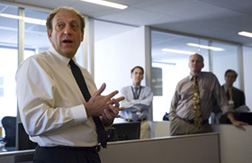Debate
In Lyons absence, Collins first stop for a second opinion was Daniszewski, who as senior managing editor and vice president for international news and photos was Lyons boss. Daniszewski was struck by the emotion of the scene of two Marines tending to a fallen comrade, framed by trees and a ditch wall in the fading light. Its fuzzy quality to him made it look almost like a painting. On an aesthetic level, Daniszewski felt that the picture wasnt especially gory and that taste alone didnt argue against its distribution. On a news value level, moreover, he says, I do remember having the reaction that this picture really does tell a story. It was a timely story, at that. Daniszewski explains:
It was at a point in the war where the Obama administration had decided to escalate in terms of sending more troops and making a real bid to turn the tide of the war in Afghanistan after it had been somewhat ignored for a long time. And as a consequence, US casualties were rising pretty rapidly So in my mind, these were other elements that in Afghanistan clearly had become much more perilous, even for our reporters and photographers, obviously, and for the US troops. And that the real cost of the escalation, whether you agreed with it or disagreed with it, should be reportedthat it would mean more fighting, and as a consequence more casualties.
Listen to Daniszewski talk about his first reaction to the photo.

Senior Managing Editor Michael Oreskes and
fellow AP staff members.
Associated Press
The photo soon became the subject of much interoffice debate, and over the next few days several editors visited Collins desk to view it. The ultimate decision on whether or not to distribute it, however, belonged to Kathleen Carroll, who as executive editor was responsible for all of APs content in all its formats. She examined the photo soon after Daniszewski. She and Collins blew it up on a big screen and adjusted the lighting several different ways, she explains, not to produce it that way, but because you want to make sure that youre seeing everything that the picture shows. [1] She was focused on determining how much blood there was, whether Bernards face was clear, and how intimateor intrusivethe photograph felt.
Aside from the question of whether to move the photograph, Carroll also considered what would be the best way to do itwhat other kinds of journalism should accompany it. If the AP did distribute the photo, she did not want it to stand by itself simply with a caption identifying Bernard. She explains:
I think we were all leaning toward moving the picture, but I felt that we wanted to not just fling the picture out there. And so I asked [news editors] to make this young man a person, to find out who he was, to have more reporting on the circumstances under which he was wounded and killed People should understand; the picture is so rare they should understand something about the man whose mortal wounding they are viewing.
Daniszewski assigned a reporter to attend Bernards funeral and interview his family. De Montesquiou would gather more background on Bernard from other members of Golf 2/3. In the meantime, Carroll felt it wise to set the final decision on distribution aside while editors awaited news about photographer Morenatti. She says: I dont want us to make a decision while we are in the throes of some fairly strong emotions about our own guy who had his leg blown off.
[1] Authors interview with Kathleen Carroll in New York City, on June 24, 2010. All further quotes from Carroll, unless otherwise attributed, are from this interview.